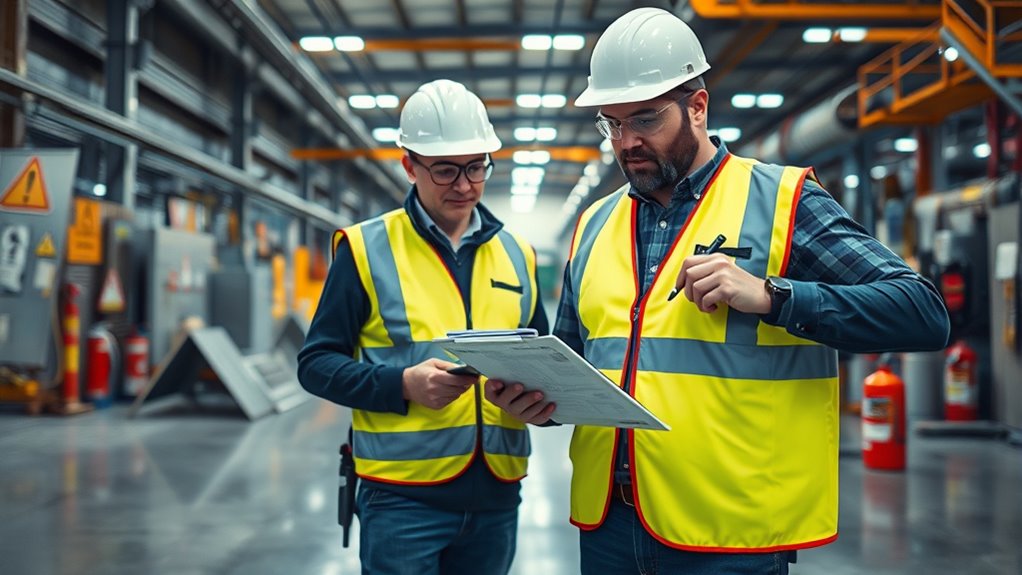Regular safety audits help you identify hazards, guarantee compliance, and promote ongoing safety improvements in your environment. By reviewing procedures, inspecting physical conditions, and observing employee behaviors, you can pinpoint vulnerabilities and take corrective actions. This proactive approach reduces risks, prevents accidents, and supports a safety-focused culture. Staying consistent with audits shows your commitment to safety and keeps your environment compliant and secure. Keep exploring to uncover more ways to enhance your safety practices.
Key Takeaways
- Regular safety audits identify hazards and areas for improvement, promoting ongoing safety enhancements.
- They facilitate the development of targeted corrective actions to address vulnerabilities proactively.
- Continuous audits foster a safety culture by involving employees and encouraging feedback.
- Ongoing assessments ensure compliance with evolving regulations and industry standards.
- Implementing audit findings supports dynamic safety management and reduces workplace accidents.

Have you ever wondered how organizations guarantee their workplaces remain safe and compliant? It all starts with thorough safety audits, which serve as a vital tool for identifying potential hazards and ensuring adherence to compliance standards. When you conduct a safety audit, you’re fundamentally performing a detailed risk assessment that evaluates every aspect of the work environment. This process helps you pinpoint vulnerabilities that could lead to accidents or injuries, allowing you to take proactive steps before issues escalate. By systematically reviewing safety protocols, equipment, and employee practices, you’re actively managing risks and fostering a culture of safety.
Implementing regular safety audits ensures that compliance standards are consistently met and maintained. These standards are often set by regulatory agencies, industry best practices, and internal policies, serving as a benchmark for a secure working environment. When you perform an audit, you compare current practices against these standards to identify areas where your organization may fall short. This comparison helps you develop targeted improvement plans, whether it’s updating safety procedures, providing additional training, or upgrading equipment. Staying aligned with compliance standards not only minimizes legal and financial risks but also demonstrates your commitment to employee well-being.
Regular safety audits ensure compliance, identify gaps, and support continuous improvement for a safer workplace.
During a safety audit, you examine physical conditions, review safety documentation, and observe employee behaviors. This all-encompassing approach allows you to gather valuable data that informs your risk assessment. For example, you might discover that certain machinery lacks proper guarding or that safety signage is unclear, both of which pose potential hazards. Recognizing such issues enables you to prioritize corrective actions based on the severity and likelihood of risks. This ongoing process creates a dynamic safety management system that adapts to changing conditions, new equipment, or updated regulations. Additionally, fostering a culture of continuous creative practice within your organization helps employees feel empowered to suggest safety improvements and innovations.
Furthermore, safety audits foster a mindset of continuous improvement within your organization. When you regularly review safety practices and address deficiencies, you build a resilient safety culture. Employees are more likely to follow safety protocols when they see management actively engaging in hazard identification and mitigation. This proactive approach helps prevent accidents before they happen, reducing downtime and associated costs. Ultimately, by integrating risk assessments with compliance standards into your safety audits, you’re not just avoiding violations—you’re creating a safer, more productive environment where everyone feels protected and valued.
Frequently Asked Questions
How Often Should Safety Audits Be Conducted?
You should conduct safety audits regularly, ideally following your safety schedule, which often recommends every three to six months. Audit frequency depends on your industry, workplace hazards, and previous findings. Consistent audits guarantee you identify risks early and implement improvements swiftly. By sticking to a set schedule, you maintain a proactive approach to safety, showing your commitment to a safe environment and reducing potential accidents or violations.
Who Should Be Involved in the Safety Audit Process?
You should involve a diverse group of stakeholders in the safety audit process, including employees, management, and safety experts. Their engagement ensures thorough insights and commitment. You also need to provide proper training and education to all participants, so they understand audit procedures and safety standards. By actively involving stakeholders and investing in ongoing training, you create a culture of continuous improvement, making your environment safer and more compliant.
What Are Common Challenges During Safety Audits?
Challenges during safety audits often feel like steering through a maze, but they mainly stem from limited employee participation and incomplete audit documentation. You might struggle to get honest feedback or find gaps in records that hinder accurate assessments. Maintaining engagement and ensuring thorough documentation can be tough, yet these are vital for continuous improvement. By addressing these issues, you create a clearer path toward a safer environment where everyone’s input counts and records support lasting change.
How to Prioritize Issues Found in Safety Audits?
You should prioritize issues by conducting a thorough risk assessment to identify the most critical hazards first. Focus on safety concerns that pose the highest risk to employees and operations. Once identified, implement corrective actions promptly, addressing high-priority issues before moving to less urgent ones. This approach guarantees that you’re effectively reducing risks and maintaining a safer environment, aligning your efforts with continuous improvement principles.
What Tools Are Most Effective for Safety Audits?
Think of safety audits as your guiding compass through a maze. You’ll find inspection checklists invaluable, providing a clear map of potential hazards you might overlook. Pair these with digital reporting tools, transforming your observations into real-time data that illuminates problem spots instantly. This dynamic duo streamlines your process, making safety checks more thorough and efficient, ensuring you stay ahead of risks and foster a safer environment.
Conclusion
By regularly conducting safety audits, you guarantee your environment stays secure and risks stay low. Some might think audits take too much time, but in reality, they prevent costly accidents and downtime. Think of safety audits as an investment in peace of mind—protecting your team and your operations. When you commit to continuous improvement, you create a safer space where everyone can focus on their work confidently and effectively.








